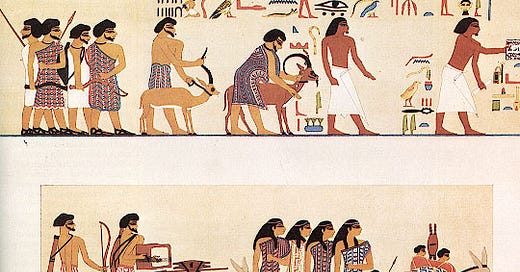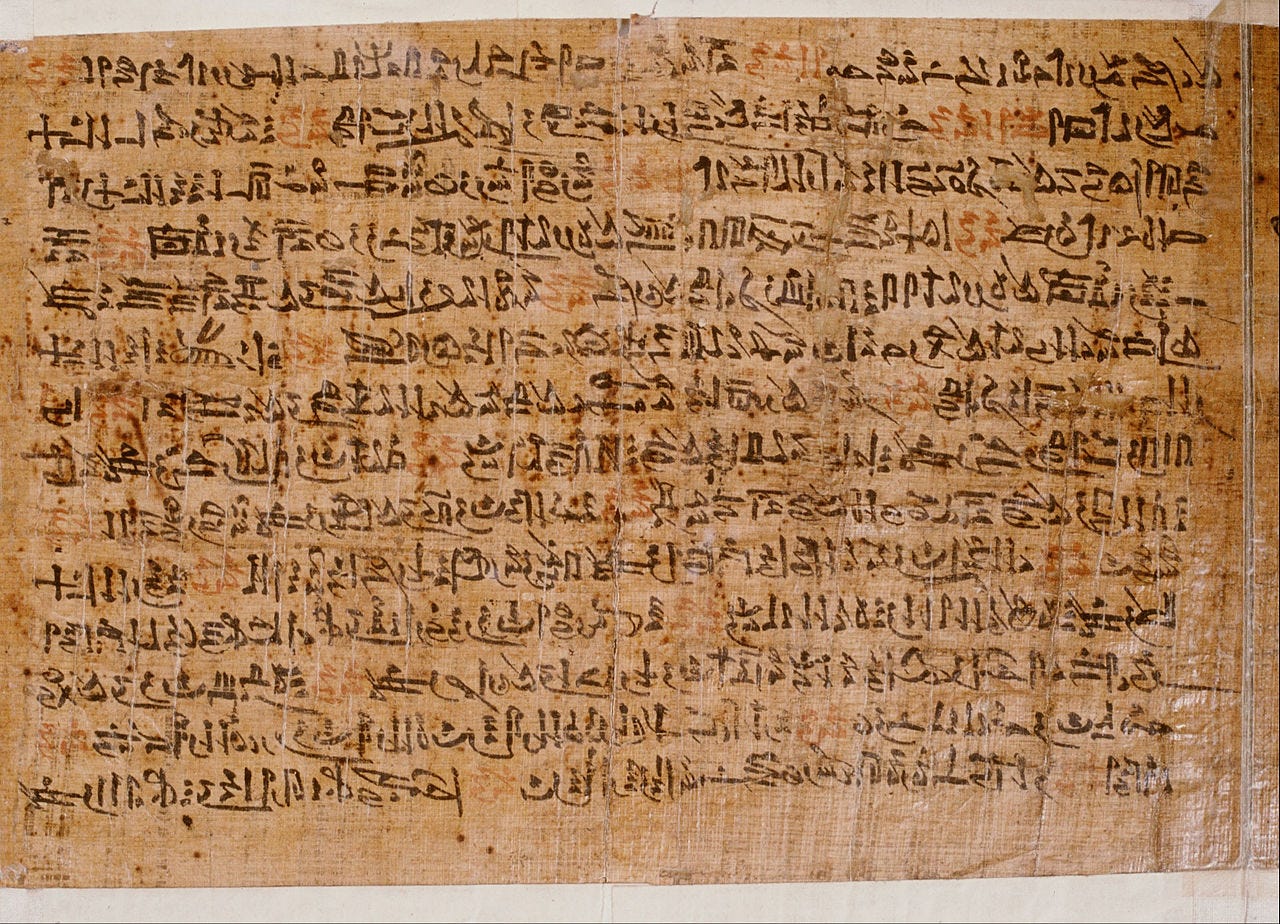This week, I spent considerable time investigating the evidence for the Exodus. According to the Bible story, Joseph brought his family to Egypt, where they stayed for 400 years. Moses led the Hebrews out of Egypt, taking the gold and silver, leaving the place in shambles, and crossing an impossible desert. Logically, this story is improbable in many ways. Who could pull it off?
Outside of the Bible, there are multiple artefacts[1] that support the story extremely well.
1. There’s a famous painting called the Ibscha Relief at Beni Hassan in central Egypt, that shows semitic peple migrating into Egypt. The people are identifiable as Hebrews by their skin color, hair, beards, and goods such as a harp. Unlike Egyptians, they wear bright multicolored garments (like Joseph’s ‘dreamcoat’). The date for this painting is earlier than Joseph, but might line up with Abram’s Biblical visit to Egypt.[2]
2. On Sehel Island on the Nile, there’s a large boulder inscription called the Famine Stele, which records a story about a seven-year famine and a dream by the Pharaoh that provided an answer.[3] Also, there are seven large grain silos that were built around the time of Jacob and Joseph, nearby at Tell Edfu.[4] (This matches the Bible account of Joseph interpreting Pharaoh’s dream and saving the country from a 7 year famine)
3. More than 27 different scarabs (royal seals) have been found with the name “Yaqub-har” engraved on them. There is no “J” in Hebrew. This translates as “Jacob’s Hill” to us. They date to about 1730 BC or earlier. (In the Bible, Joseph’s father Jacob comes to Egypt with the whole clan, and all of them would have used Yaqub-har as a designation during the 1700s BC.)
4. An Egyptian historian called Manetho wrote about a group of rulers called the “Hyksos”, including Salit and his successor, Benon. Almost all records of the six Hyksos rulers have been systematically wiped out (suggesting a deliberate attempt to erase a period of history). The Hyksos are identified as Hebrews by the Roman historian Josephus. (The word Salit was the title of governor given to Joseph in the Bible, and Joseph’s younger brother was Benjamin. Notably, in Genesis 35:18, Benjamin’s mother Rachel called him Ben-oni, not Benjamin.)
5. There’s an entire city on the Eastern side of the Nile delta that was abandoned during the reign of Amenhotep II. Called Avaris, or Tell el-Dab’a, the town has unusual characteristics such as the complete lack of any bones from pigs, as well as Levantine architecture, tools, and burial practices. Unusually, this town was abandoned suddenly and nobody moved in there. One important note is that the biggest, grandest tomb (associated with Joseph) had the bones removed, unlike any other tomb in Egypt. In the Bible, we learn that Moses took the bones of Joseph along when he left.
6. There’s an early form of Hebrew writing, at a turquiose mine in Egyptian Sinai from about 1500 BC.[5]
7. The Egyptians themselves are well known as propagandists in their writing, and any defeat is difficult to find in the records. But there is a scroll from the 13th century BC, which is believed to be a copy of a destroyed record made by a royal scribe named Ipuwer in roughly 1450 BC. This matches the story of Exodus extremely well!
a. The time frame is the same as the Biblical account.
b. Ipuwer mentions “the river is blood, yet men drink of it”. (Exodus 7:20: “All the waters that were in the river were turned to blood”)
c. Ipuwer cites pestilence, barley crop failure, and “lack of light”. (Exodus 9-11 lists the same disasters, including gnats, flies, locusts, boils, hail, and darkness)
d. Ipuwer records that “every dead person is as a well-born man”, including princes. He wrote that “Men are few, and he who places his brother in the ground is everywhere.” (Exodus 12:30: “There was not a house where there was not one dead”)
e. Importantly, Ipuwer wrote that “poor men have become owners of wealth”, including gold and silver. (Exodus 12:35: “The children of Israel…asked of the Egyptians jewels of silver, and jewels of gold”)
f. Note that Ipuwer’s record blames all of these problems on the “shepherd people” that came to Egypt generations before. “Shepherd people” is a great description for the Hebrews at that time.
8. There’s a “400-year stele” in Tanis, Egypt, that commemorates a 400-year period related to the Hyksos (Hebrew) people. It was installed during the reign of Ramesses II, after the Hyksos had left Egypt, and shows that there was an endpoint to the Hebrew time in Egypt. (This matches the Biblical account of a 400-year period for Hebrews in Egypt)
9. The earliest archaeological evidence of Hebrews in Canaan/Palestine dates to roughly the 14th century BC…after the migration from Egypt to Canaan.[6]
There’s more to cover, on the Red Sea crossing and Jewish survival in the desert…but this article is already getting too long. For this week, I simply conclude that we have excellent historical/archaeological evidence that a group of people migrated from Asia to Egypt, stayed for 400 years, then left—with gold and silver--during a time of pestilence and disaster for Egypt. It’s a phenomenal match with the broad brush strokes of the Bible story. Even the crazy details line up.
Without getting into the specific miracles listed in the Bible, we can marvel at this incredible story. There is no parallel. What other group of people migrated into a country, lived there for hundreds of years as both governors and laborers, and then suddenly left with all of the loot? It sounds like fiction, but it’s supported by hard evidence.
The Hebrews are called the “Chosen People”. Maybe that’s like being chosen as God’s tackling dummy…they get knocked down and He helps them to get up again. The Hebrews have been beat down and exiled three times (Egypt, Babylon, Rome) and they keep returning. They maintain cohesion every time. They’ve even brought their dead language back to life in the last round. Today, they’re surrounded by enemies and indicted by the ICC, but I would not bet against them.
[1] https://armstronginstitute.org/878-did-the-israelites-really-live-in-egypt
[2]https://armstronginstitute.org/33-uncovering-the-bibles-buried-civilizations-the-egyptians
[3] https://www.egypttoday.com/Article/4/54056/Famine-Stela-A-piece-of-Pharaonic-diary
[4] https://news.uchicago.edu/story/archaeologists-find-silos-and-administration-center-early-egyptian-city
[5] https://armstronginstitute.org/235-evidence-for-worship-of-the-golden-calf
[6] https://en.wikipedia.org/wiki/Merneptah_Stele







